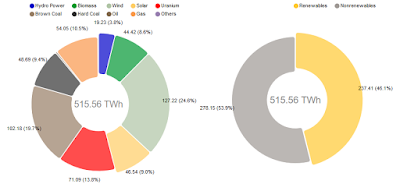The 110 MW Crescent Dunes Solar Energy Project in Nevada was the world’s first utility-scale facility to use molten salt power tower energy storage. It has 10,347 tracking mirrors (heliostats) that follow the sun and reflect and concentrate sunlight onto a heat exchanger, a receiver, atop a 640-foot (200 m) tower.
Crescent Dunes is designed for 10 hours of storage and was to deliver 500,000 MW hours of electricity per year, day and night, to 75,000 homes. In September 2011, SolarReserve received a $737 million loan guarantee from the U.S. Department of Energy (DOE) for the project and broke ground. The project had a 25-year agreement with NV Energy for 100 percent of the electricity, but this was terminated by NV Energy in October 2019 due to the project having "failed to produce." Alleging a takeover by the DOE, SolarReserve has raised the possibility of this project filing for bankruptcy.
Cost of Solar Technology in $ Per Megawatt-Hour (Source & credit: BloombergNEF)
According to a recent article in Bloomberg (
LINK), cheap solar panels have grown wildly more efficient in recent years, and that is a disaster for such companies as SolarReserve that can’t easily upgrade their dated components. As can be seen in the graph above, the current cost (2019) per megawatt-.hour is almost 2.5 times higher for the Cresent Dune plant as compared to a photovoltaic solar farm.
Crescent Dunes Solar Energy Project as seen from an airliner (Wikipedia)
Background: SolarReserve (
LINK)





